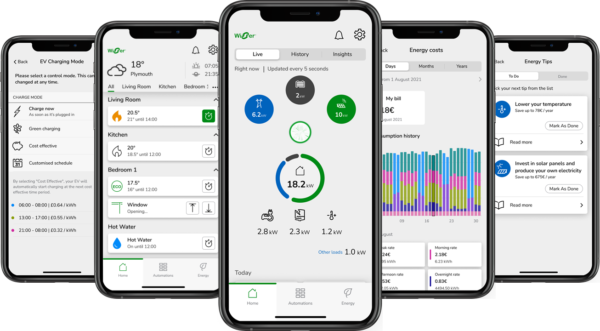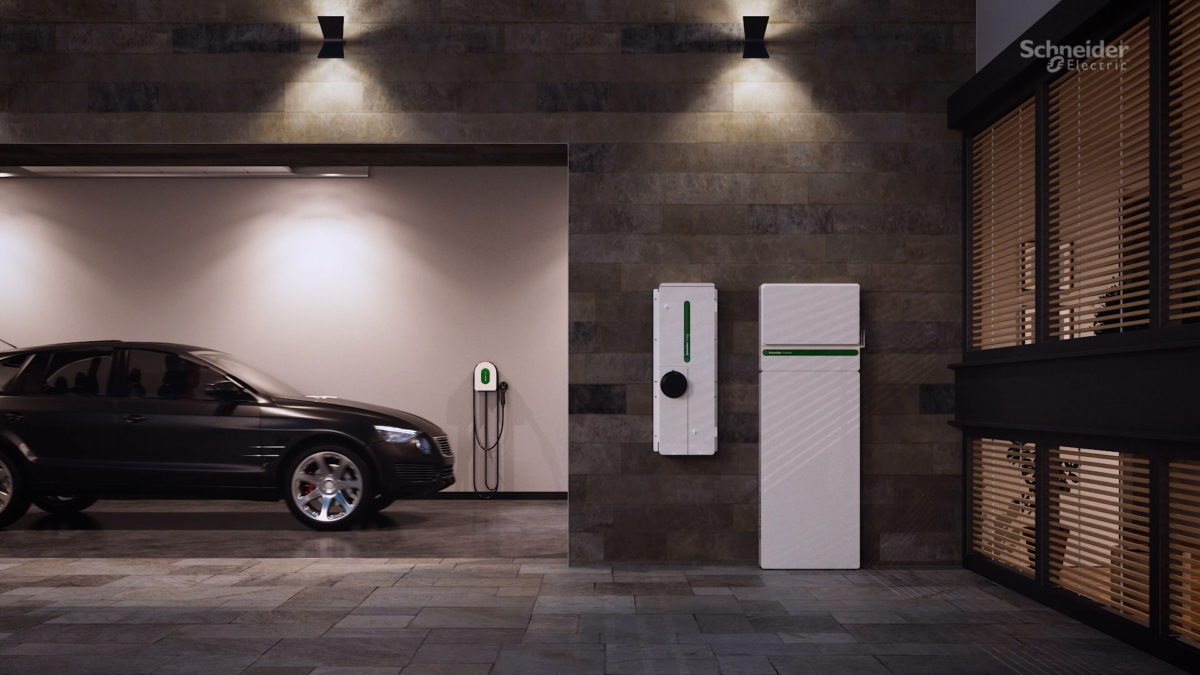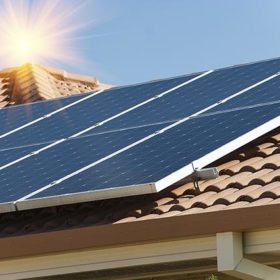Swiping through any number of smartphone applications, a homeowner can see the throughput power coming in from his or her rooftop solar array during the afternoon while their EV charges in the garage or fills a battery storage system. This week, Schneider Electric unveiled the Schneider Home platform, the first consumer energy management system (EMS) that integrates all energy endpoints and household appliances in one interface that can be monitored via a single smartphone application.
The Schneider Home system was released a day before the kick off of the 2023 Consumer Electronics Show (CES) conference, taking place January 5 through 8 in Las Vegas, where the company has been recognized as a 2023 Innovation Award Honoree for the new platform.
The residential platform allows users to not only monitor the energy consumption of household appliances, it also allows users to prioritize power during outages to extend available back-up power during power outages to appliances such as the refrigerator or freezer.
At the utility level, the residential EMS platform provides additional energy cost savings by allowing for the enrollment in utility programs such as net metering. It can also help qualify the homeowner for tax incentives such as the solar investment tax credit for installing solar and storage solutions.
In contrast to existing solutions that require individual apps and hardware, Schneider Electric has eliminated the complexity for homeowners by automating energy production, storage, measurement and control. Recognized by CES, Schneider Home’s sleek styling and integrated approach mark a new age of home energy management solutions.
“Homeowners are now able to produce their own energy and seamlessly switch between power sources to optimize cost,” said Nadege Petit, executive vice president of innovation at Schneider.
The Schneider Home platform consists of five home components that integrate energy resources and digital capabilities, including:
- Schneider Pulse: A smart electrical panel powered by embedded technology, functionality, and intelligence to interconnect various energy sources.
- Schneider Boost: The battery for energy storage that stores solar energy during the day and uses it during peak rates for utility bill savings and to keep power flowing during outages.
- Schneider Inverter: The high-power hybrid inverter for solar and storage that converts solar energy output into usable AC electricity.
- Schneider Charge: The EV charger leverages onsite solar and storage to boost charge speed and reduce charging costs.
- Schneider Home: The smartphone application control system allowing the monitoring, control and automation of the whole energy management through a single app.

Schneider Electric
For an existing home, Schneider Electric reports that it makes the most sense when a customer needs to make updates to their electrical system, for example, if they are adding a new technology such as an EV and charging system. The residential system includes the solar inverter, but system installation would require other aspects of the solar system such as wire harnessing and electrical equipment to be provided separately by an electrician or EPC contractor, a company spokesman told pv magazine USA.
Schneider Electric brings together disparate home energy technologies into an integrated, open, and streamlined system – all controlled by a single app with unique capabilities, including:
- Predefined and customizable energy saving settings, like ‘Away Mode,’ to power off non-critical appliances when not needed, customize lighting settings and battery set-up.
- Intelligent EV charging when rates are lowest – or directly from solar.
- Reduced time and complexity of installation in comparison to legacy systems
- Minimal footprint and streamlined design taking up less space than current configurations – less clutter, more curb appeal.
“Choice, control, convenience – these are the characteristics that consumers are looking for in every experience. What better or more meaningful place to deliver that than in their own homes?,” said Jaser Faruq, senior vice president of innovation and energy storage at Schneider. “We took the opportunity to reimagine home energy placing the customer at the center, then designing a full-featured, integrated system around their needs and paired with an intuitive app to simplify its operation.”
Faruq joined Schneider Electric in September 2021 to head up the Schneider Home platform after a six-year tenure at Tesla, where he was head of business operations for the EV manufacturer’s Residential Energy business, as well as solar roof growth and operations lead manager.
Over the last two years, Schneider Electric has been on a corporate acquisition spree for products that comprise many core solutions found in the Schneider Home platform, such as EV Connect, Qmerit, Zeigo, EnergySage and AutoGrid Holdings, whose technologies include residential EV charging, climate-technology data, and distributed energy resources integration. In May 2021, the energy solutions provider launched a retail website to sell distributed resources such as solar and energy storage products.
Paris-based Schneider Electric is a Fortune Global 500 company formed in 1836 as a steel, mining and electrical service company. From 1981 through 1997, the company divested out of the steel, mining and shipbuilding markets to become a full-service electric solutions provider, primarily through acquisitions.
The company currently trades at EUR 139.80 ($148) per share, with an $84.5 billion market capitalization.
This content is protected by copyright and may not be reused. If you want to cooperate with us and would like to reuse some of our content, please contact: editors@pv-magazine.com.









“”Schneider Boost: The battery for energy storage that stores solar energy during the day and uses it during peak rates for utility bill savings and to keep power flowing during outages””. Schneider is the parent company to APC that has been making uninterruptable power supplies for years. A UPS, plugged into a wall outlet, gets charged when the utility is powered on and then seamlessly switches over to the internal battery to keep the appliance, computer, lights or whatever running until the battery runs out. Put a timeclock between the wall outlet and the UPS, you can select your own switch over from grid power to battery power. Add a bank of external batteries and have extended run times all with the APC ups units already on the market. having this capability already built in will be a great value if the pricing is right and they use longer running lithium Ferus phosphate batteries that last over 10 years and not the 3-to-5-year lead acid batteries now installed in UPS units. This could be just in time for California’s NEM 3.0 giving Schneider a very large market indeed. integrating with rooftop solar.